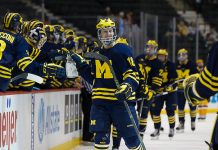
Hello again, and welcome back to the USCHO Hobey Watch, and yes, Michael Mersch has my attention now.
Last week, when running down the leaders in the Hobey Baker Award online fan voting, I mentioned that Mersch, the senior forward from Wisconsin, was in the top 10, but I didn’t address his chances further. Well, he sure showed me, delivering the most impressive goal I’ve seen in college hockey since Kyle Okposo’s between-the-legs score against Minnesota State in 2006 (and it may even be better … I’m not sure).
So, what do I think of Mersch’s chances to earn a Hobey finalist berth? I think he has a reasonably good chance. Working in his favor: He’s a senior, he’s a goal-scorer (17th nationally and second in the Big Ten), and he’s on a team that’s on track for an NCAA tournament berth.
That having been said, there are at least two other strong candidates out of the Big Ten in Minnesota goaltender Adam Wilcox and Ohio State forward Ryan Dzingel, and it will be interesting to see how many of the 10 finalists come out of college hockey’s newest (and, by membership, smallest) conference. He’s certainly someone worth keeping an eye on, though. If nothing else, you just might see another highlight-reel goal!
Now, to the main business of the week: goaltending.
I’ve touched on goaltending a couple of times in the Hobey Watch this year. I came into the season wondering whether we might see a run at the Hobey from Jon Gillies of Providence or Connor Hellebuyck of Massachusetts-Lowell. While Hellebuyck has shown no signs of a sophomore slump — he leads the nation in GAA (1.76) and is second in save percentage (.942) — he’s also still splitting time with senior Doug Carr, who’s having a laudable season in his own right (second in GAA at 1.80, fifth in save percentage at .934).
It’s not unheard of for a goalie who splits time in net to get a Hobey finalist bid (Miami’s Cody Reichard did it in 2010 while platooning with Connor Knapp), but if Hellebuyck is going to be the first goaltender to win the Hobey since Ryan Miller in 2001, it’s not going to be this year.
As for Gillies, he’s having a fine season, sitting 15th nationally in save percentage (.927) and 21st in GAA (.924), and he’s certainly a big part of Providence’s success. The question becomes whether that’s enough to snag a Hobey finalist berth, and I’m somewhat doubtful.
In that same post, I took note of Ferris State netminder CJ Motte, who has established himself as the most notable player for the strongest team in the new-look WCHA. With a top-20 save percentage (.924) for the conference leader, I think Motte has a solid chance of snagging a finalist berth, particularly with such limited competition for a spot within his own conference.
Minnesota State forward Matt Leitner is the only other WCHA player I could see getting a finalist berth, and if the Mavericks were to overtake the Bulldogs in the conference standings, his case could grow stronger.
After that start, we introduced two more goalie names into the mix last week, based in part off of their standing among the top 10 vote-getters in the Hobey online fan balloting: Minnesota’s Adam Wilcox and St. Cloud State’s Ryan Faragher.
As I noted last week, Faragher doesn’t look like an especially viable candidate (save percentage .904 — 54th nationally; GAA 2.68 — 47th), but Wilcox is looking more and more to be a likely Hobey finalist, posting a .930 save percentage (10th in the country) and a 1.97 GAA (11th) for a No. 1 team that took its first conference loss just Thursday.
Now, as we look at goaltending in earnest, there are two more names that we need to add into the mix: Denver’s Sam Brittain and Northeastern’s Clay Witt. Brittain is holding down the nation’s third-best save percentage (.936) and 10th-best GAA (1.96) for a Pioneers team that sits second in the NCHC. Witt leads the nation in save percentage (.945) for a Northeastern team that is in position for an NCAA tournament berth.
The thing that interests me about Brittain is this: Among NCHC candidates, he appears to have the best combination of team and individual success this season. Miami has a pair of outstanding players in Riley Barber and Austin Czarnik, but the RedHawks sit seventh in the eight-team NCHC.
On the other hand, conference-leading St. Cloud State has a somewhat intriguing candidate in sophomore forward Jonny Brodzinski, but his numbers (14-12–26, 1.08 points per game) aren’t superlative at the level of Brittain’s.
Nebraska-Omaha’s Josh Archibald is a stronger candidate than Brodzinski, particularly as the nation’s No. 3 goal-scorer, and is probably Brittain’s biggest competition within the conference, but I have a feeling that Brittain will probably be the guy that gets the most Hobey love when it comes time to pick the finalists.
As for Witt, the best save percentage in the country says it all — or at least, it says most of it. After all, that save percentage puts him in Ryan Miller’s neighborhood, and for better or worse, Miller remains the standard against which netminding Hobey contenders are judged.
The other thing that’s worth mentioning here is that Witt has had to make more saves than all but two other goalies in the country this year — his 745 saves rank third behind Holy Cross netminder Matt Ginn (788) and Bentley’s Branden Komm (775). All told, Witt sees 35.8 shots a game, and if he didn’t turn aside as many as he does, the Huskies likely wouldn’t be having the season they’re having, even with the top-10 offense that they boast.
Witt will have a prime opportunity to showcase his prowess between the pipes on Monday, when the Huskies face Boston College in the Beanpot final. If Witt puts on a show against Johnny Gaudreau and the Eagles en route to Northeastern’s first Beanpot title since 1988, it will be a major feather in his cap, and will seriously bolster his case for a finalist berth, a spot in the Hobey Hat Trick, and maybe, just maybe, the award itself (although I still feel like Gaudreau is the leader).
Finally, I know that a lot of what I write focuses in on statistics, which aren’t always the best way to judge a player’s value to a team. The reason is simple: More often than not, the Hobey is, in large part, a stat-driven award. That doesn’t always mean that the leading scorer in the nation gets the award; in fact, it often doesn’t mean that.
What it does mean, however, is that while it’s hard to win the Hobey at all, it’s even harder to win it without truly elite numbers. The obvious exception in recent memory was Matt Gilroy in 2009, but his win had such a strong narrative behind it — returning to BU after more than 20 offers to turn pro; Jack Parker’s comments about the value of Gilroy’s leadership; his journey from walk-on to All-American — that it was able to capture the attention of voters without elite-level numbers to back it up.
More often, however, it’s hard for Hobey voters to see enough of each candidate to have a really good read on them. The coaches, who vote for the finalists, spend most of their time focusing on their own opponents, while the media voters, likewise, give most of their attention to their own conferences. You can see highlights and catch some extra games from outside your region, but at the end of the day, a lot of it is still going to come down to stats, and that’s where we are.
That’s it for now. Enjoy your weekend of hockey, everyone!


